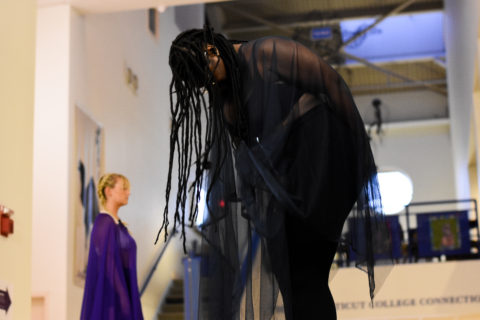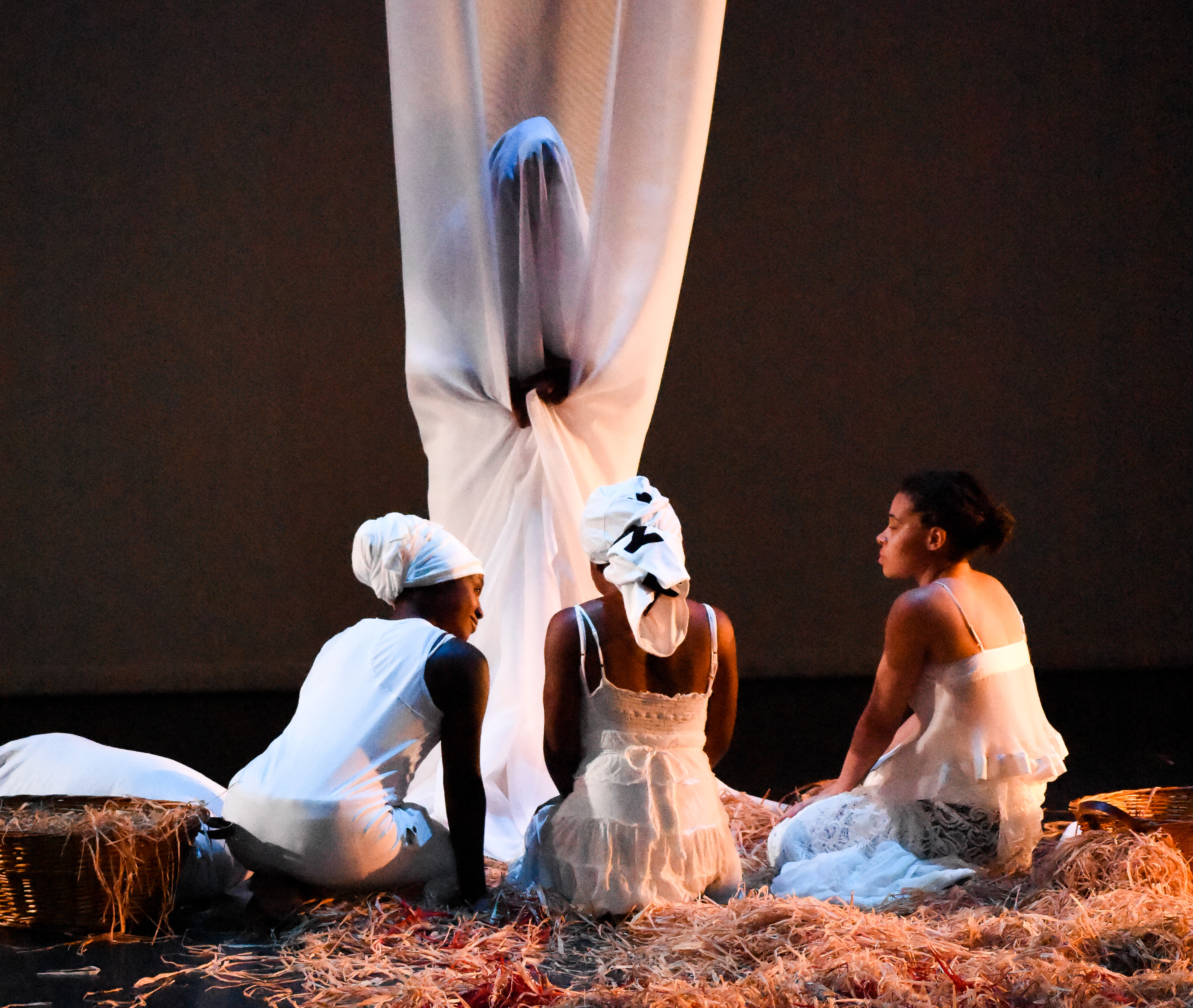Thirteen students danced on tables and counters as Nina Simone’s “Images” played in the background. The dancers, most of them women of color and draped in black or purple cloth, turned slowly on their platforms, occasionally moving separately from the rest of the group, and often jerking their arms as though running away from something. Pieces of quilting made by New London-based artist Kimberly Radcliffe, hung from the walls. The individual squares of quilting depicted faces staring blankly forward. These images, combined with the dancers’ blank faces, were haunting and I felt uneasy as I bought my ticket and proceeded upstairs to the Myer’s Studio. Here, I was greeted with two dancers performing a duet. The lone movements downstairs were snippets of this same dance, which told the story of two women finding empowerment — despite having been oppressed and violated.
Both of these mini dances formed the pre-show of Where the Heart Is. A six movement performance, choreographed by Professor Shani Collins-Achille (“SNIC”), and stage managed by Angelina Annino ’20 and William Oaks IV, Shawn Hove created the lighting design with special guests Kevin DeShields, Truth Hunter, Richard Schenk, and Ayana Sequira ’21.

The first act was a series of tableaus, each exploring a different theme. The first movement, “But Some of Us Are Brave,” told the story of a black female rape survivor reclaiming her beauty and bodily autonomy. According to the program, this dance “questioned black body and stereotypes/labels such as ‘’Jezebel” and’ “Aunt Jemima.” The following act was “Intermoods,” performed by Ayana Sequira ’21. This piece used original music by Richard Schenk. The third act, “Alive: the Movement.” was grounded in Haiti’s history, including the Haitian Revolution, the U.S. invasion of Haiti, and the 2010 earthquake. In the first half of this dance, Professor Collins danced alone to Columbite (Suite No. 1) and Petro (Suite No. 1) by Frantz Casseus. In the second half, she sat on a white barrel, similar to the type aid workers use to carry water, while applying red and blue face paint, the colors of the Haitian flag, and singing in Haitian Creole.
The fourth movement, “Don’t Live Here Go,” explored the African Diaspora and spirituality. This piece began with Kevin DeShields performing capoeira (an Afro-Brazilian martial art form), ducking and kicking as though fighting an unseen opponent. As the dance progressed, Collins, Hunter and Swilley arranged hay streaked with red streamers on the stage while singing a Bambara song as Collins-Achille danced violently on the hay. As she-danced, DeShields lay a white sheet and basin on the stage. Collins-Achille collapsed, and Collins, Hunter and Swilley led her to the basin where they poured water over her as they wept. Slowly, the weeping turned to raucous laughter.
“Don’t Live Here Go” was followed by a “Porch Talk,” which also served as the show’s intermission. A child’s drawing of a house was projected onto the back wall of the Meyer’s studio. Collins, Hunter, and Swilley welcomed us to their “home,” and told stories about home. They asked the audience for their own stories while dance students played the role of the children, playing clapping games and talking while Hunter and Collins told them to quiet down.
The intermission performance was an introduction to the second act, the titular “Where the Heart Is.” The act was a multimedia performance, featuring video clips from Professor Collins-Achille’s home, music, and dance. In one video, Professor Collins-Achille interviewed her mother, Clarencia C. Collins, about her memories of home. During the interview, a video clip showed her playing the piano while Collins-Achille and her sister danced. Music is important to the family, so it was especially moving when, halfway through the performance, Clarencia C. Collins came out of the audience and performed The Heart Asks Pleasure First live on the piano while Collins-Achille danced beside her. Although most of the dancers in the performance were professors, the dance students stole the show in the last dance of “Where the Heart Is.” This energetic number featured homages to childhood memories displayed as one dancer waved his arms excitedly over a fence, similar to how a child would try to encourage a friend to come out and play.
When interviewed, Ayana Sequira ’21 said, “what I really liked about this experience is that everyone was really connecting to each other, so there’s just like a lot of comradery and support and just like a lot of love that was spread throughout that whole process.” The final dance certainly reflected this, as the dancers were clearly having fun and did not miss a beat.
While on a surface level the two acts may appear a bit disjointed, home was a fundamental theme in both acts. Losing or leaving one’s home was paramount to act one (due to a natural disaster in “Alive: The Movement” and the African Diaspora in “Don’t Live Here, Go), and returning home was the central theme of act two. Sequira said the piece felt like a reflection on a memory; “kind of like remembering for yourself and your own personal experiences and like your past, and like home. And then, outside of that, what kind of groups you’re part of, so loosely, family.”
While the current iteration of Where the Heart Is was moving, the work was described in the program as “a work in progress.” I look forward to seeing the finished product. •










